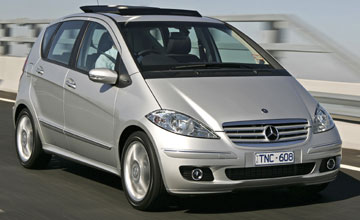BY TIM BRITTEN | 6th May 2005

Whether the first A-class delivered on all counts is a matter still open to discussion. Certainly, its basic stability was under question from the beginning when the first cars failed the infamous "Elk test".
This was addressed, apparently successfully, by Mercedes when it made electronic stability control a standard feature on all A-class models while simultaneously adjusting suspension tuning and wheel/tyre combinations to ensure the mini-Benz would remain upright whatever external pressures were brought to bear.
Now we have a second-generation A-class and the question is: does it do a better job of interpreting the original formula?
The new car apparently is a response to what customers told Mercedes they really wanted from an A-class.
The research showed that while they wanted to retain the familiar virtues such as high-level passive safety and traditional Mercedes quality levels, they wanted a new A-class to offer more interior space, more comfort and improved ride quality.
The new A-class delivers pretty well on all three counts: It’s unquestionably bigger inside than before through the extension of the overall length by a quite massive 232mm over the original, and a bumping-out of the overall width by 45mm.
The wheelbase is longer than the original short-wheelbase version by 145mm, although slightly shorter than the long-wheelbase version that followed, by 25mm.
It doesn’t quite fit into the tight parking spots pounced on gleefully by the original A-class, but it will take four tall passengers with ease while still maintaining a decent boot.
The on-road experience is better too.
With an engine range spanning the 1.5 litre, 70kW engine through to a forthcoming 142kW 2.0-litre turbo, there’s an A-class to suit everyone prepared to spend $30,000 and upwards on a compact car.
As you’d expect, the base 1.5-litre three-door A-class is pretty much that: A base, entry-level Mercedes, albeit with a price tag well below anything the company has offered in recent years.
On the road, the 1.5-litre A-class with its revised front and new "parabolic" rear suspension, as well as selective damping, is more absorbent than before, pretty quiet and comfortable at cruising speeds but, largely because of its still-upright stance, quite sensitive to crosswinds lacking somewhat in engine response.
The engine response thing can be quite easily dealt with simply by spending more money on the more powerful 1.7-litre, 85kW and 2.0-litre 100kW versions - or, later this year, on the 142kW turbo.
But the slightly nervous feeling seems to be an intrinsic character flaw that even an electromechanical steering system cannot fully address.
The packaging is impressive though. Even a 185cm driver will leave room enough in the back seat for an equally tall rear passenger, and there’s headroom aplenty throughout the cabin – as well as a decent boot that can be extended by quickly folding the asymmetrical split-fold rear seat.
The quality of the German-built A-class seems better than before, and the general interior comfort is really quite outstanding, from the well shaped front seats to the generally ergonomic controls.
It’s pretty quiet on the road, considering we’re talking about a car not much different in size to your regular light-car offering from Hyundai or Honda.
It’s less a compromised package than the original, with genuine load space available even with all seats in place, and a quite gargantuan interior if the ability to remove both the rear and front passenger seats are exploited.
And it looks better too, which makes you wonder why the first A-class couldn’t have been a little less awkward and upright than it is.